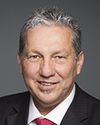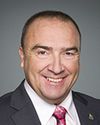On page 7 of your presentation, you say that “these investments reflect in part only governmental action in official languages”.
What are the other parts?
Evidence of meeting #3 for Official Languages in the 42nd Parliament, 1st Session. (The original version is on Parliament’s site, as are the minutes.) The winning word was roadmap.
A recording is available from Parliament.
5:20 p.m.
Liberal

Dan Vandal Liberal Saint Boniface—Saint Vital, MB
On page 7 of your presentation, you say that “these investments reflect in part only governmental action in official languages”.
What are the other parts?
5:20 p.m.
Director General, Official Languages Branch, Department of Canadian Heritage
Tying into the question about the total cost estimate, I would say that other departments are also sensitive to minority language community issues. Just think of Fisheries and Oceans Canada, which works directly with minority language communities, especially in New Brunswick. Because of that interaction with minority language communities, the department is aware of their situation and adapts its approach accordingly.
Similarly, Agriculture and Agri-Food Canada works with rural minority communities on a regular basis, and because it understands their situation, the department tailors its involvement to that reality.
That is also the case with Global Affairs Canada, which is sensitive to the need to provide services in both official languages abroad. It has an obligation to do so. That said, it strives to promote minority communities, particularly as regards immigration. It provides support to French-language universities and post-secondary institutions in minority situations through the recruitment of foreign students coming to study in Canada.
I listed off three quick examples, but it would be possible to provide a report on every federal institution. We ask them to let us know what they are doing to help communities under part VII of the act, and every year, we learn things that surprise us. We discover wonderful things we were completely oblivious to within one federal institution or another.
5:25 p.m.
Liberal

Dan Vandal Liberal Saint Boniface—Saint Vital, MB
You have the authority, then, to request reports and evaluations from other departments on all those initiatives.
5:25 p.m.
Director General, Official Languages Branch, Department of Canadian Heritage
Yes.
5:25 p.m.
Assistant Deputy Minister, Citizenship and Heritage, Department of Canadian Heritage
I would just add that 14 departments and institutions contribute to the roadmap, but the Department of Canadian Heritage's annual report mentions several dozen institutions.
5:25 p.m.
Director General, Official Languages Branch, Department of Canadian Heritage
Over a three-year cycle, we ask 170 federal institutions that we have identified to provide us with a report. We do it over a period of three years because looking at 170 institutions all at the same time is a pretty hefty task, so three years gives us enough time to cover all 170 of them.
Some key institutions are required to produce a report every year, but others, whose official languages focus is less prominent, are required to provide us with a report every two or three years.
The three-year cycle helps us gain an overview of all the federal institutions subject to the Official Languages Act.
5:25 p.m.
Liberal

Dan Vandal Liberal Saint Boniface—Saint Vital, MB
Very well.
You started to answer my next question. What's the difference between official languages programs and the roadmap?
5:25 p.m.
Director General, Official Languages Branch, Department of Canadian Heritage
My branch is responsible for the host of official languages programs, which are largely based on section 43 of the Official Languages Act. That section tells the Minister of Canadian Heritage to take action on a series of issues, and those issues are reflected in the host of official languages programs under the department's responsibility.
The programs don't contribute to the roadmap 100% but, rather, 20% or 30%, depending on the program. They contribute to the $1.1-billion investment. The official languages programs target education, second-language learning, and minority communities. We mentioned the community cultural action fund, as well. Those are all components of the heritage department's official languages programs. They partly overlap with roadmap investments but go further.
5:25 p.m.
Liberal

Dan Vandal Liberal Saint Boniface—Saint Vital, MB
Okay. I see.
Immigration is one of the roadmap's three priority sectors. In September 2014, the government put an end to the francophone significant benefit program, an immigration program created to support francophone minority communities. The purpose was to make it easier to hire skilled French-speaking workers.
Do you have any information on that cancelled program?
5:25 p.m.
Director General, Official Languages Branch, Department of Canadian Heritage
A bit.
My colleagues at Immigration, Refugees and Citizenship Canada would definitely be able to give you more details. Right off the bat, though, I would say that the program wasn't intended solely to encourage francophone immigration. Among other things, it helped promote francophone immigration to minority communities. The decision was the result of broader public policy immigration objectives, in terms of how temporary immigration is handled, particularly seasonal workers.
The decision to eliminate the program stemmed from problems that came to light in 2013-14 involving temporary foreign workers, and it had the unfortunate effect of overriding the component designed to promote francophone immigration.
5:25 p.m.
Liberal

The Chair Liberal Denis Paradis
Thank you, Mr. Vandal.
The next members we will hear from have five minutes. Mr. Blaney and Mr. Nater will be sharing that time.
5:25 p.m.
Conservative
5:25 p.m.
Conservative

Steven Blaney Conservative Bellechasse—Les Etchemins—Lévis, QC
We've already split our speaking time.
5:25 p.m.
Conservative

Bernard Généreux Conservative Montmagny—L'Islet—Kamouraska—Rivière-du-Loup, QC
As we've been hearing since the beginning, you are, to a certain degree, the watchdogs for the cross-government application of the Official Languages Act and its various components.
You talked about immigration a moment ago. So far, you're giving us the impression that you're doing everything perfectly, or just about. Earlier you brought up a potential hurdle with respect to immigration. Could you elaborate on that? What problems did you observe in those services?
5:25 p.m.
Assistant Deputy Minister, Citizenship and Heritage, Department of Canadian Heritage
The hurdle in question referred to the challenge our colleagues at Immigration, Refugees and Citizenship Canada encounter when trying to increase the proportion of francophone immigrants to provinces other than Quebec. That's really the crux of the challenge. Progress has been made, albeit slowly.
5:25 p.m.
Conservative

Bernard Généreux Conservative Montmagny—L'Islet—Kamouraska—Rivière-du-Loup, QC
When you talk about francophone immigration, are you referring to targeted immigration or immigration, in general?
5:25 p.m.
Assistant Deputy Minister, Citizenship and Heritage, Department of Canadian Heritage
I'm referring to francophone immigrants from French-speaking countries such as France or Belgium, as well as from Arab-speaking countries where French is a language that is taught. Immigrants from Maghreb countries, for instance, could be expected to integrate into francophone communities in Manitoba or New Brunswick.
5:30 p.m.
Conservative

Bernard Généreux Conservative Montmagny—L'Islet—Kamouraska—Rivière-du-Loup, QC
Indeed, they might come from northern Europe, as well.
Everyone knows that, over the last three months, Canada has taken in some 25,000 Syrian refugees. Are you able to tell us where things stand with that group? Did they settle in any official language minority communities? Do you have any figures on that yet?
February 24th, 2016 / 5:30 p.m.
Assistant Deputy Minister, Citizenship and Heritage, Department of Canadian Heritage
We don't have any figures on that for the time being. That's a project being managed by Immigration, Refugees and Citizenship Canada. We don't have any data on the Syrian immigration or the refugees who will settle or have settled in official language minority communities.
It's also important to understand that community agencies have been given a very large role in the settlement and integration of the immigrants. I know my counterparts at the Department of Immigration, Refugees and Citizenship are trying to make sure that francophone community agencies working on integration in minority communities are part of the discussion.
You asked me about the results so far, but I don't have the data to give you an answer.
5:30 p.m.
Conservative

Bernard Généreux Conservative Montmagny—L'Islet—Kamouraska—Rivière-du-Loup, QC
Mr. Chair, I move that the committee invite officials from the Department of Immigration, Refugees and Citizenship to provide an update on the settlement of these recently arrived immigrants. They could tell us the extent to which immigrants have settled in official language minority communities.
5:30 p.m.
Some hon. members
Agreed.